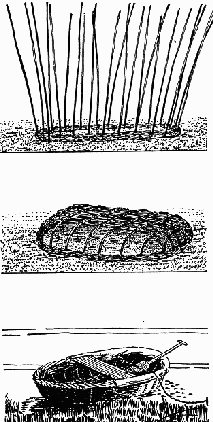Making a Curragh:
"On the leval sward--his
rustic shipyard--the boat-builder first marks out, with string
and pegs, two semicircles of
a 2 ft.radius their
centers being about twenty inches apart. This will give the basket
a mouth measuring 6ft by 4 ft, a size determined by the average
size of a hide. Joining
the two circles into an ellipse,
he thrusts into the ground along this line, at ingervals of about nine
inches, long pointed hazel rods which have been cut the previous autumn
after the leaf fall and allowed to season. They are pushed about six inches
into the ground,at an angle so that they slope outwards somewhat.
At one end, the bow-to-be, an extra rod is inserted
on either side to give strength
where the weight of the kneeling paddleman will fall. Against
the ground a strong gunwale of withies is woven on to the rods, and
above it a skirting of lighter withies. Opposite rods on each side
are now bent over and their thin ends
pushed into the ground to secure them temporarily. The fore and aft rods
are similarly
bent over and heavy stones
placed on the basket, their weight distributed so as to make a symmetrical
frame with the top (that is the bottom of the curragh)as nearly flat as
possible. At this state two or three days
are allowed for the frame to set. Then the crossings of the rods
are lashed with a continuous twine and again the frame is left weighted.
The thin ends of the rods are now broken off at thelast lashings in such
a way as to leave the bark projecting to prevent the ends from damaging
the hide. This, which has meanwhile been softening in the river is
sewn on to the gunwale with twine, the basket having been pulled out of
the ground and inverted. The thwart is fixed in position amidship,
its ends suspended from the gunwale with withy ties, and withy braces
are laced across the stern portion to form a rest for
the net. Sitting on
the thwart, the boat-builder
now drives in the projecting
rod-ends to tighten
the skin, and trims them
to within an inch of the gunwale. Finally he weaves on a protecting
mouth of hazel rods which he binds to the gunwale and covers, behind the
thwart, with canvas to save the net from damage as it iss played out."
 - -
(the Boyne curragh-used
for salmon
fishing) Irish Folk Ways,
E.Estyn Evans,
Routledge and Kegan Paul,
London,pp.234-236 |
|
Starving in a Sea of Seafood!
"So rude is their tackle and so fragile and liable
to be upset are their primitive boats or coracles, made of wickerwork over
which sail cloth is stretched, that they can only venture to sea in fine
weather and thus, with food almost in sight, the people starve"-James
H. Tuke, 1846
This page will explore how a people could starve when located within
a sea filled with abundant food resources. How did culture contribute?
What about cultural dietary taboos? What about cooperation vs. competition
of fishermen? As usual there are many facets for discussion. More will
appear here soon! Let us know your suggestions!
In her famous work The Great Hunger Cecil Woodham-Smith responds
to this issue with a environmental determinism which pits strong and determined
fishermen against an all powerful sea and cliffs. There is little
background provided to demonstrate that the government's opinions
of Irish fishermen were not based upon hard fact-that as her account of
the Claddagh fishermen demonstrates Irish fishermen were a class
unto themselves and extremely hard to deal with-even in the face of famine.
Woodham Smith does expose significant cultural concerns which do indicate
that "fisherman culture" was a factor as strong as those of the environment
in the limitation of efficient exploitation of the resources of the sea.
My comments are inserted into Woodham-Smith's account click
here
In 1833 the Royal Commission chaired by Archbishop Whately recommended
that the government should promote economic development by developing the
fisheries this suggestion was not in keeping with the political philosophy
of the time and was rejected. |
 -
-